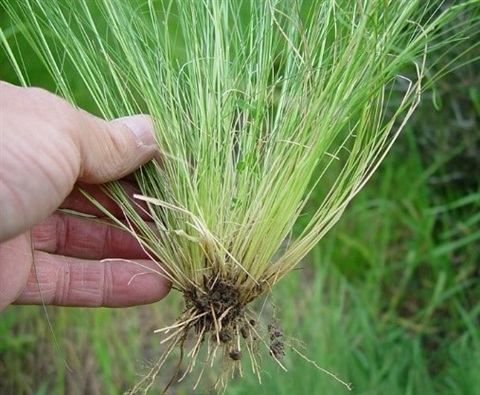Serrated Tussock Discovered on Adelong Falls Walk
Published on 08 December 2020

Adelong Falls Walk users are asked to keep to the path and keeps dogs on leads on the path after a small patch of serrated Tussock was noted at the area. The plant seeds prolifically and the seeds spread easily on animal fur.
A small patch of serrated Tussock (nassella trichotoma) consisting of 5 tussock plants has been noted on the edge of the Adelong Falls Walk just over the first bridge coming from the Falls to Adelong. The plants were manually removed and the area treated with fluproponate.
A small patch like the one noted has the ability to overwhelm and take over a large area within only a few years, if unchecked. Each plant produces about 140,000 viable seeds per season, and it is a very costly and difficult undertaking to get rid of Serrated Tussock.
Serrated tussock is not palatable to stock. Animals grazing on it become malnourished very quickly. Sheep and cattle will lose weight and eventually die having starved to death with full bellies of partly digested tussock. Serrated tussock can easily take over pastures and native vegetation reducing the pasture quality and contaminate hay and grain. It also puts at risk numerous native vegetation communities such as native grasslands, grassy woodlands, and dry alpine forests.
Serrated tussock can completely take over new areas within 4 years. It is hard to get rid of. A single plant can produce up to 140,000 seeds each season. Seeds spread easily by wind and water and by animals. The seeds also remain viable when passing through an animal. Control is costly and herbicides used to control serrated tussock impact other grasses, especially natives.
Description
Serrated tussock grows in upright tussocks up to 45 cm tall and 25 cm wide. In spring the clumps are light green with brown tips to the leaves. In late spring and early summer, the clumps have a purple tinge when the seed heads emerge fully. Plants remain green in summer when other grasses turn brown. After frost the clumps turn a golden yellow. The leaves are whitish (no red or purple) at the base, looking like shallots, and they are tightly rolled not folded, narrow, stiff and upright, and they feel serrated when drawing the leaf between your fingers. The roods are deep and fibrous and it is difficult to pull out of the ground, even when small.
What can you do?
If you find serrated Tussock, even small individual plants, control plants as soon as they appear and before they set seed. Limit animal movement from infested areas into clean paddocks.
- Quarantine stock from infested areas for at least 10 days to pass seed through the gut before releasing them to clean paddocks.
- Avoid bringing hay, grain, or silage from serrated tussock areas onto your property.
- Inspect hay or fodder (even from clean areas) for weed seeds.
- Revegetate unproductive areas with trees and shrubs to resist invasion.
- Minimize soil disturbance on sandy soils - ploughing can cause a flush of seedling growth.
- Plant windbreaks to reduce seeds blowing in.
- Clean vehicles and machinery before moving into clean areas.
The most expensive weed control is doing nothing. Delaying control of odd plants or light or scattered plants allows a quick transition to more and more plants. These quickly become more difficult and more costly to control. Maintaining healthy pastures is the best long-term defence against serrated tussock. Serrated tussock is unlikely to establish in a good perennial pasture with legumes. Thin and bare patches in the pasture are at most risk of invasion.
Physical removal
Remove individual plants with a mattock in small, isolated patches. Bag and dispose of the removed plants. Also dispose of soil attached to roots as it may contain seeds. Tussocks with flowers should be burnt after removal.
Sow pasture seed where the ground is bare.
Chemical control
Most herbicides used to control serrated tussock contain either glyphosate or flupropanate. Pasture species have variable tolerance to these herbicides. Check which pasture species are present. Follow up is essential for successful control.
Herbicides are most effective in combination with healthy, competitive pastures.
For more information contact Council’s Biosecurity Officer, Mel Wilkerson on 02 6941 2547
-ENDS-